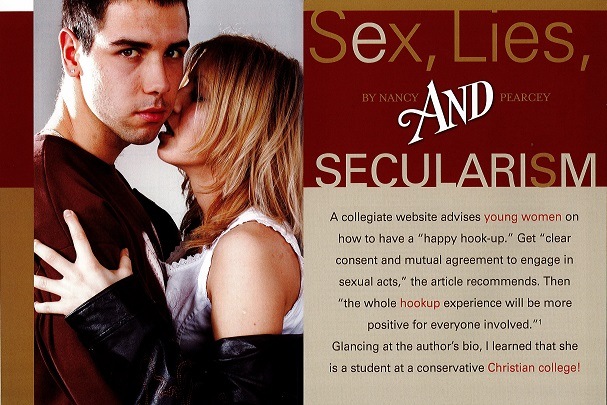This article first appeared in Christian Research Journal, volume 34, number 04 (2011). For further information or to subscribe to the Christian Research Journal go to: http://www.equip.org
A collegiate website advises young women on how to have a “happy hook-up.” Get “clear consent and mutual agreement to engage in sexual acts,” the article recommends. Then “the whole hookup experience will be more positive for everyone involved.”1
Glancing at the author’s bio, I learned that she is a student at a conservative Christian college!
When even Christian young people are buying into the hookup culture, it’s clear that traditional ways of teaching biblical morality are no longer effective. “Just say no” is not enough. Young people don’t need simple rules; they need reasons to make sense of the rules. Which is to say, they need to be taught the worldview rationale for biblical morality. Otherwise it is possible for Christian young people to be sincere in their faith, yet thoroughly secular in their thoughts—and, consequently, in their behavior.
Every system of sexual morality depends on a prior view of nature. In Western society, until the modern age, nature was regarded as God’s handiwork, created for His purposes. To use a technical term, Christianity implies a teleological view of nature—from the Greek telos, which means a thing’s goal, purpose, or ideal state. Because humans are created in God’s image, their goal is to become true reflectors of God’s character. The moral law is simply the road map telling us how to reach that goal, the instruction manual for progressing toward God’s ideal.
That instruction manual is derived primarily, of course, from God’s communication in Scripture. But another source is creation itself. We can read signs in nature that indicate God’s original purpose—traces of God’s image that remain even in a fallen world.
For example, the biological correspondence between male and female is not some evolutionary accident. It is part of the original creation that God pronounced “very good”—morally good. Thus it provides a reference point for morality. Our physical anatomy signals a divine purpose for male and female to form covenants for mutual love and the nurturing of new life. Biblical sexual morality is not arbitrary. It reflects the purpose for which we were created.
By contrast, secular morality rests on a view of nature that rejects teleology, acknowledging only blind, material forces. Historically, the turning point was Charles Darwin. The central elements in his theory—random variations sifted out by the mechanical process of natural selection—were proposed expressly to get rid of the concept of purpose or design in biology. As cultural historian Jacques Barzun writes, the “denial of purpose is Darwin’s distinctive contention.”2
This had profound moral implications. For if nature was not the handiwork of a personal God, then it no longer bore signs of God’s good purposes—which meant it no longer provided a basis for moral truths.
The next step was crucial: because nature did not reveal God’s will, it became a morally neutral realm on which humans may impose their will. There was nothing within nature that humans were morally obligated to respect. It was merely raw material to be manipulated and controlled to serve human needs and preferences.
GETTING OFF THE GROUND FLOOR
How does this history explain the rise of liberal sexual morality? The human body is, of course, part of nature and therefore it too came to be seen as raw material subject to the choices of the autonomous self. In the words of Roger Lundin of Wheaton College, both nature and the body were recast as “essentially amoral mechanisms to be used to whatever private ends we have.”3 In other words, because the human body has no intrinsic purpose, we can use it any way we choose.
But who is this “we”—this choosing, controlling self that uses the body for its own purposes? For all its claim to be modern, liberalism has surprising affinities with the philosophy of Plato in the ancient world. Plato taught a dualism in which the soul uses the body instrumentally to affect the world—like a charioteer driving a chariot, as he put it.
An updated version of dualism stems from René Descartes. Philosopher Daniel Dennett (who himself rejects dualism) explains: “Since Descartes in the seventeenth century we have had a vision of the self as a sort of immaterial ghost that owns and controls a body the way you own and control your car.”4 That is, most modern people unconsciously hold a view of the human body as a form of property that can be controlled and manipulated to serve the self’s desires.
What does this dualistic view of the person mean in practice—especially in sexual practice? It has created an expectation that the self is free to use the body any way it chooses, without serious consequences. In short, it has led to the hook-up culture.
“What makes hooking up unique is that its practitioners agree that there will be no commitment, no exclusivity, no feelings,” explains an article in the Washington Post.5 By definition, hook-ups are purely physical encounters with no expectation of any personal relationship. Hook-up partners are referred to as “friends with benefits,” but that’s a euphemism because they are not really even friends. The unwritten etiquette is that you never meet to just talk or spend time together, explains a New York Times article. “You just keep it purely sexual, and that way people don’t have mixed expectations, and no one gets hurt.”6
Except, of course, that people do get hurt. The same article quotes a teenager named Melissa who was depressed because her hook-up partner had just broken up with her.
In practice, people cannot dualistically separate the self from the body. Rolling Stone magazine interviewed a college student who stated the problem succinctly: people “assume that there are two very distinct elements in a relationship, one emotional and one sexual, and they pretend like there are clean lines between them.”7
Do you recognize the language of dualism? Young people have come to believe that sexual relationships can be solely physical, disconnected from the mind and emotions—with “clean lines” between them.
Philosophers often illustrate dualism using the image of two stories in a building. In the lower story is the body, which since Descartes has been regarded as a biochemical machine. In the upper story is the autonomous self—with a “clean line” separating the two.
THE SELF
Mind and emotions
___________________________
THE BODY
Biochemical machine
George Bernard Shaw recognized the problem in his 1931 play Too True to Be Good. “When men and women pick one another up just for a bit of fun, they find they’ve picked up more than they bargained for, because men and women have a top storey as well as a ground floor,” says one character. “You can’t have the one without the other. They’re always trying to; but it doesn’t work.” Today’s young people are still trying to have one without the other. But it still doesn’t work.
Of course, the fact that it does not work ought to tell us something. It means the hook-up culture rests on an inadequate conception of human nature. People are trying to live out a worldview that does not fit who they really are.
Because humans are created in God’s image, their experience will never quite “fit” a secular view of human nature. In practice, non-Christians will always bump up against some point of contradiction between their secular worldview and their real-life experience. That contradiction provides an opening to make the case that the secular worldview is flawed. It fails to explain human life and experience.
Young people like Melissa are trying to live out a worldview that does not match their true nature—and it is tearing them apart with its pain and heartache.
DISSING THE BODY
The same destructive worldview explains the current acceptance of homosexuality. Even in churches, many young people do not “get” why homosexual activity is morally wrong. The biblical rejection of homosexuality makes more sense when we understand the implicit worldview—which is, once again, a dehumanizing dualism.
Think of it this way: biologically and physiologically, males and females are clearly counterparts to one another. The male sexual and reproductive anatomy is obviously designed for a relationship with a female, and vice versa. Homosexual practice overrides that clear design built into the structure of our bodies.
As a result, it expresses a profound disrespect for our physical anatomy. Essentially it says that anatomy has no intrinsic purpose but is just a mechanistic system of glands and organs that one can use any way one chooses.
As a result, homosexual practice requires individuals to contradict their own biology. It disconnects a person’s sexual feelings from his or her biological identity as male or female—which exerts a self-alienating and fragmenting effect on the human personality.
Some Christians propose that God creates some people as homosexuals. But if so, says Tim Wilkins of Cross Ministry (himself a former homosexual), then “God has played a cruel joke on them. He has engineered their minds and emotions for attraction to the same-sex and yet created their physiology to be in direct opposition to that attraction.”8
And the logic of alienation will not stop there. Already the acceptance of same-sex relationships is leading to a full-blown postmodern conception of sexuality as fluid and changing over time. In Saving Leonardo I quote a psychotherapist addressing the problem faced by individuals who had come out of the closet as homosexual, but were later attracted to heterosexual relationships again. So what am I, they asked.
The psychotherapist’s response was, essentially to not worry; it’s okay to change your sexual identity whenever you wish. In his words, today people “don’t want to fit into any boxes—not gay, straight, lesbian, or bisexual ones.” Instead “they want to be free to change their minds.”9
This view of sexuality, the psychotherapist stated, is “a challenge to the old, modernist way of thinking” that you were born with a gender that does not change because it is rooted in our biological identity. Instead we are moving to a postmodern view that gender is something I can choose, independent of biology. The implication is that I might have been straight yesterday, but I can be homosexual today, and maybe bisexual tomorrow. One’s psychosexual identity is said to be in constant flux.
In fact, human nature itself is thought of as a social construction, something we make up as we go along. We can call this view liberalism, employing a definition by the self-described liberal philosopher Peter Berkowitz: “Each generation of liberal thinkers” focuses on “dimensions of life previously regarded as fixed by nature,” then seeks to show that in reality they are “subject to human will and remaking.”10
In other words, previous generations thought there was a fixed, universal human nature that expressed a God-given teleology. For example, they thought heterosexual marriage was rooted in human nature. It was the way humans were created to function.
By contrast, liberalism denies that there is any fixed or universal human nature. Humans are an accidental configuration of matter, a product of blind evolutionary forces. Marriage is a social behavior that evolved because it was adaptive at some point in evolutionary history. It is not intrinsic to human nature, however. In fact, there is no human nature. Therefore we are free to redefine marriage at will. It is open to unlimited “human will and remaking.”
WHICH GENDERS HAVE YOU BEEN?
This rejection of human nature has ever-widening implications. The cutting-edge issue today is transgenderism, a movement that rejects the distinction between male and female itself as a social construction—and an oppressive one at that.
Several universities now offer separate bathrooms, housing, and sports teams for transgender students who do not identify themselves as either male or female. The New York Times reports that some schools no longer require students to check male or female on their health forms. Instead, they are asked to “describe your gender identity history.”11 That is, which genders have you been over the course of your lifetime?
The concept of gender has become fluid, free-floating, completely detached from physical anatomy. This is typically presented as liberating—a way to create your own identity instead of accepting one that has been culturally assigned. A few years ago, California passed a law requiring schools to permit transgender students to use the restroom or locker room of their preferred gender, regardless of their anatomical sex. The new law12 defined a student’s gender as including “gender related appearance and behavior whether or not stereotypically associated with the person’s assigned sex at birth.”13 Notice the assumption that a person’s sex is “assigned,” as though it were purely arbitrary instead of an anatomical fact.
The law is being used to impose a postmodern concept of the person that denies any intrinsic dignity to the unique biological capabilities inherent in being male or female. Physical anatomy is treated as insignificant, inconsequential, and completely irrelevant to gender identity. An Oakland elementary school teaches young children that “gender is not inherently nor solely connected to one’s physical anatomy.”14 This is a devastatingly disrespectful view of the physical body.
It also endangers human rights. Rights are based on the recognition that there are certain nonnegotiable givens in human nature, prior to the state, which the state is obligated to respect. But if human nature itself is merely a social construction, something we make up as we go along, including our psychosexual identity, then there is nothing in the individual that is given, which the state is obligated to respect—and thus no basis for inalienable human rights.
If America accepts practices such as same-sex “marriage,” in the process it will absorb the accompanying worldview—the redefinition of human personhood as a purely social construction—which opens the door to unlimited statism, because there is no human nature that an oppressive state could possibly offend.
GOD LIKES MATTER
Ironically, Christians and others who respect the givens of human sexuality are often dismissed as prudes and Puritans because of their “repressive” sexual morality. Yet the biblical worldview actually affirms a much higher view of the body than the secular utilitarian view. It offers the radically positive affirmation that the material world was created by God, that it will ultimately be made whole by God, and that God was actually incarnated (made flesh) in a human body.
In the ancient world, these biblical claims were so astonishing that the Gnostics rejected them. They taught that Jesus was really an avatar who only appeared to have a human body. They could not accept the idea of a Creator who actually likes matter because He created it—a God who affirms our material, biological, sexual nature.
Today, in an unexpected twist of history, it is once again Christianity that is defending a high and holistic view of the human person.
Most churches, sadly, do not communicate a high view of the person. A 2007 Barna survey of adult churchgoers under the age of thirty found that about fifty percent said, “They perceive Christianity to be judgmental, hypocritical, and too political.”
These are not critics from outside the church, but young people sitting in the pews. Moreover, the study found that this generation exhibits “a greater degree of criticism toward Christianity than did previous generations.”
Nowhere is this more true than on hot-button issues such as sexuality. Only by digging beneath the surface and refocusing on the worldview level can we show young people why secular views of sexuality are harmful and alienating. A worldview focus gives us the tools to craft a positive approach that expresses love and concern for people caught in destructive life patterns.
Nancy Pearcey’s latest book is Saving Leonardo, on which this article is based. She is also the author of the bestselling, award-winning Total Truth: Liberating Christianity from Its Cultural Captivity. Pearcey currently teaches at Rivendell Sanctuary.
NOTES
- Ally Karsyn, “The Drunken Hookup Double Standard,” Her Campus, April 30, 2011.
- Jacques Barzun, Darwin, Marx, Wagner: Critique of a Heritage (New York: Little, Brown, and Company, 1941), 11.
- Roger Lundin, The Culture of Interpretation: Christian Faith and the Postmodern World(Grand Rapids: Eerdmans, 1993), 102.
- Daniel Dennett, “The Origin of Selves,” Cogito 3 (Autumn 1989): 163–73.
- Kathy Dobie, “Going All the Way,” Washington Post, February 11, 2007.
- Benoit Denizet-Lewis, “Friends, Friends with Benefits, and the Benefits of the Local Mall,” New York Times Magazine, May 30, 2004, http://www.nytimes.com/2004/05/30/magazine/friends-friends-with-benefits-and-the-benefits-of-the-local-mall.html.
- Janet Reitman, “Sex and Scandal at Duke,” Rolling Stone, June 1, 2006.
- Tim Wilkins, “Cruel Joke or Medical Anomaly?” http://www.crossministry.org/index.php?option=com_content&view=article&id=69:cruel-joke-or-medical-anomaly-proponents-of-same-sex-qmarriageq-owe-us-an-nswer&catid=35:published&Itemid=65.
- Bret Johnson, quoted by Laura Markowitz, “The Postmodern Queer Identity Movement,” Utne Reader, September/October 2000.
- Peter Berkowitz, “Rediscovering Liberalism,” The Boston Book Review, March 1995.
- Fred Bernstein, “On Campus, Rethinking Biology 101,” The New York Times, March 7, 2004.
- http://leginfo.public.ca.gov/pub/07-08/bill/sen/sb_0751-0800/sb_777_bill_20070409_amended_sen_v98.html.
- http://www.aroundthecapitol.com/Bills/AB_887/20112012/.
- Russ Jones, “Parents Defenseless against Gender ‘Diversity Training,’” OneNewsNow, May 26, 2011.









